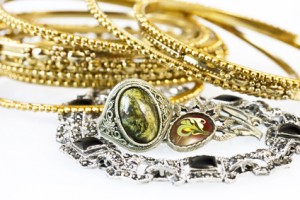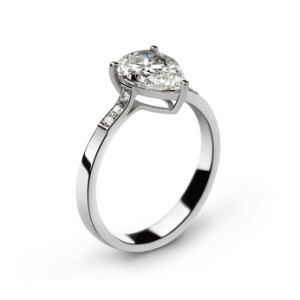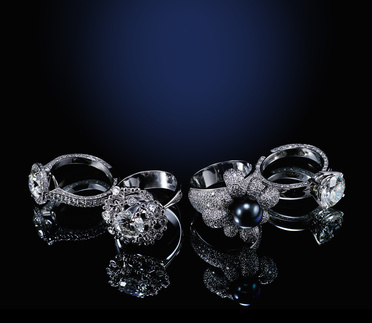How Is White Gold Different from Yellow Gold?
If you look closely at how white gold is made, you will realize that it is just yellow gold that is mixed with other metals.
The yellow gold used in jewelry is made in the same way, and the difference is only in the mixture of the additional metals used.
For example, white gold has more zinc, whereas yellow gold usually contains more nickel.
However, even with zinc mixed in, white gold still has a yellowish tint. What makes white gold really different is its plating, which is made of rhodium.
Rhodium Plating and White Gold
Rhodium is a white metal that is used as a coating in jewelry and is actually the metal that gives white gold its color. Not only that – rhodium also makes white gold more durable by covering the softer yellow gold alloy with an additional protective layer.
Since rhodium is expensive, it can add to the price of white gold jewelry and make it more expensive than yellow gold pieces.
White Gold vs. Yellow Gold Karats: Are They Different?
One of the most common concerns of people is whether white gold karats are comparable to yellow gold karats. The answer is “Yes.”

White gold is just yellow gold that is mixed with other metals.
As already mentioned, white gold is mixed with zinc, which makes the alloy look whiter than the typical yellow gold alloys.
Regardless of what metals are added to the gold alloy, its purity is measured in the same way.
For example, if a gold ring is 18 karats, this means that out of a maximum of 24 parts, 18 parts are pure gold and the rest is something else.
But 18K white gold and 18K yellow gold both have the same purity.
Downsides of White Gold
While white gold looks great when it is new, its rhodium plating wears off with time. When the rhodium comes off, the lower yellowish layer of white gold becomes visible.
How long it will take for the plating to disappear depends on how often you wear your jewelry.
The good news is that you can always have your white gold replated with rhodium to restore the original color of the jewelry. Keep in mind, however, that this service can cost around $25-$35 or more.
Is Yellow Gold Better Than White Gold?
Although white gold is not perfect, yellow gold has its own problems. Gold is a soft metal and the higher the karat of your gold jewelry is, the more easily it will get scratched.
You can always have yellow gold polished, but polishing removes a layer of the metal along with the scratches.
In contrast, when white gold gets too many scratches, you can always polish them out and have the piece replated with rhodium, restoring the jewelry’s surface layer.
Lower karat yellow gold is more durable, but if you are allergic to the nickel in gold alloys, a 10K or even a 14K piece may not work for you.
White Gold vs. Yellow Gold for Rings
Here’s what to consider when choosing between white gold and yellow gold specifically when it comes to buying a ring:

White gold ring with diamonds
Durability
Rings made of white gold are usually more durable than yellow gold ones.
The reason is not so much that white gold may contain less pure gold (which is soft), but that it is plated with rhodium, which is a pretty durable metal.
As a result, white gold rings are harder to bend and scratch than those made of yellow gold.
This is not to say that you cannot find a durable yellow gold ring, but to come close to the durability white gold offers, you would have to go with a yellow gold piece that has a low karat number.
For example, 10-karat yellow gold contains close to 60% other metals, which make the alloy harder and not easy to scratch. 18-karat yellow gold rings, on the other hand, are softer compared with white gold rings with a similar karat number.
Maintenance and Care
Since yellow gold rings are usually softer, they scratch more easily and require more frequent polishing than white gold items. In addition, a yellow gold ring needs to be checked for damage and repaired more often as its parts are more likely to bend or break.
While white gold is more durable and easier to maintain, it still requires some care. The rhodium plating of white gold rings wears off with time depending on how often you wear your jewelry.
When the rhodium layer starts to disappear, you will need to have the piece replated (usually done at jewelry shops for a fee).
And keep in mind that while white gold is harder to scratch and needs to be polished less frequently, the polishing process wears away the rhodium plating, little by little.
Nickel Content
Both white and yellow gold rings may contain nickel. If you are allergic to this metal, make sure to ask if the jewelry you are considering has nickel content.
One thing to keep in mind is that even if a white gold ring contains nickel, its rhodium plating will keep it from coming into contact with your skin.
However, when the rhodium wears off, you might get a rash if you are allergic and the nickel concentration is high enough. To be on the safe side, look for rings that are at least 14 or 18 karats, or buy jewelry that is nickel free.
Gold Color
It is up to you whether you would prefer the color of yellow or white gold.
However, if your ring will have diamonds, keep in mind that if their color is low grade, any yellowish tints in the stones will be amplified as they will stand out in a white gold setting.
For such diamonds, a yellow gold mounting will be better as they will look whiter against it.
Price
The price of gold depends on its karat, but usually, a white gold ring will be more expensive than a yellow gold one, even when they have the same karats.
This is mainly due to the rhodium plating white gold jewelry has: Rhodium is expensive, and rings with thicker plating will be pricier (but also more durable).
What Ring to Choose?
In sum, pick a white gold ring if you like the color and are ready to pay more for better durability. Also, if you will have a colorless or nearly colorless diamond set in your ring, white gold is the way to go.
Yellow gold is a better choice if you prefer a warmer color and are willing to sacrifice some durability for a lower price. A ring made of yellow gold is also a better choice if your diamond has some yellowish tints.
White Gold vs. Yellow Gold: Which Should You Buy?
Both yellow and white gold have their downsides, and while white gold has a slight edge when it comes to durability, neither is a perfect choice in this respect. If you don’t care for that difference, then make your choice primarily based on color.
If your jewelry will have a diamond set in it, and if the diamond is of a lower color grade (such as K or L), for example, have it set in yellow gold so that the diamond’s yellowish tint doesn’t stand out as it would in white. If you want to see what such diamonds look like, take a look at this selection of K/L-color loose diamonds.
In contrast, if your diamond is graded Colorless (D-E-F grades) or Nearly Colorless (G-H-I-J grades), it would be a better idea to have it mounted in white gold, which will add to the stone’s white brilliance. You can see examples of Colorless diamonds here, and this here is a selection of Nearly Colorless diamonds.
If you need guidance on how to pick a diamond, read our diamond buying guide.
If you want something more durable than white gold, consider platinum, for which white gold was actually created as a substitute.
Platinum is a lot more expensive, but it doesn’t scratch as easily, and even after you polish it many times, you don’t need to have it replated, unlike white gold.
Where to Buy Gold Jewelry?
For jewelry with diamonds, emeralds, rubies, or sapphires, we recommend James Allen (read review) because it allows you to take a 360-degree look at any stone before having it set in gold.
Blue Nile is another reputable diamond retailer we recommend.














